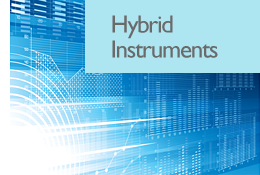Hybrid Instrument Pricing Models
One size does not fit all. SciComp offers two types of solutions for customers seeking hybrid instrument pricing models.
Custom Developed Pricing Models
Unlike vendors that rely upon pre-built libraries or toolkits, SciComp’s Custom Developed Pricing Models are built to exact customer specifications using state of the art numerical methods and customer selected interfaces and have comprehensive documentation and a complete description of the model implementation. A source code licensing option is available. Find out more.
SciFinance: Technology of Choice for In-house Model Development
SciFinance automatically generates efficient C/C++-family pricing model source code from high-level model specifications. With hundreds of customizable, composable, industry-proven examples to choose from and a robust, transparent modeling environment, users can easily and rapidly create bespoke models for all asset classes. Find out more.
Hybrid instrument pricing models
SciComp provides robust pricing modeling solutions for hybrid instruments. SciComp supports both industry standard and user-defined model dynamics for all asset classes, including, but certainly not limited to:
- Equity Derivatives
- FX Derivatives
- Commodity Derivatives
- Convertible Bonds
- Interest Rate Derivatives
- Cross Currency Structures
- Energy Derivatives
- Credit Derivatives
Arbitrary user defined models: SciComp supports the implementation of any derivatives pricing model valued using systems of partial differential equations (PDEs), stochastic differential equations (SDEs), or analytic functions. Therefore, users may define a nearly unlimited range of public-domain and proprietary models.
Custom calibration routines
SciComp can quickly and economically implement custom calibrators for users looking for either public domain or proprietary calibration routines that are tailored to their specific needs and requirements. Custom Calibrators are available for a broad range of pricing models including:
- Equity/FX/commodity models including many parameterized local volatility, stochastic volatility (with and without jumps), and pure jump models.
- Generic short rate models (including popular Gaussian and lognormal flavors) with interest rate and/or hazard rate calibration to volatility term structure of cap/swaptions and CDS spreads or corporate bonds.
- LIBOR market model calibration. Several parameterizations of the correlation matrix are available as well as several approaches for including volatility skew.
- Credit models, including survival/hazard rates from credit spreads, base correlation and semi-analytic models with deterministic or stochastic factor loading.
Many models accommodate can time dependent parameters, either exactly through numerical models of the calibration instruments, or through very fast approximate analytic techniques. Several robust optimization techniques are available, both gradient-based and stochastic.

